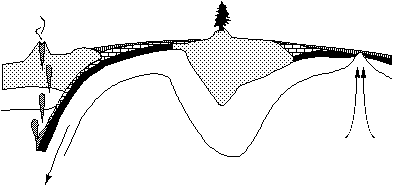
Lab # 5 - EARTH CYCLES

Lab # 5 - EARTH CYCLES
Introduction
Use your lecture handouts, lab 1 notes, and the lecture notes on
the WWW to help you answer the questions. Additional information is provided
here.
Limestone CaCO3, MgCO3
Sandstone SiO2
Coal C,H,O
Black shale SiO2, C
Chert SiO2
The elements most important to earth cycles are C, O, Si and Ca.
2. Indicate where the following occur: Metamorphism, volcanism, crustal melting. (Each may occur in more than one place.)
3. (a) Where is heat generated?
(b) Where does this heat manifest itself at the surface?
5. What processes of the Plate Tectonic cycle is it formed by?
7. What layers (& parts of layers) of the
earth make up the lithosphere? What elements make up the lithosphere?

II. CARBON CYCLE
A. On the diagram:
2. For each arrow,
(a) Name and describe the process in words.
(b) What chemical reactions occur?
3. Where are the carbon sources?
4. Where are the carbon sinks?
6. What (if any) element does it act as a sink for?
7. State its role (if any) in the carbon cycle.

1. Plate tectonic cycle

2. Carbon cycle
